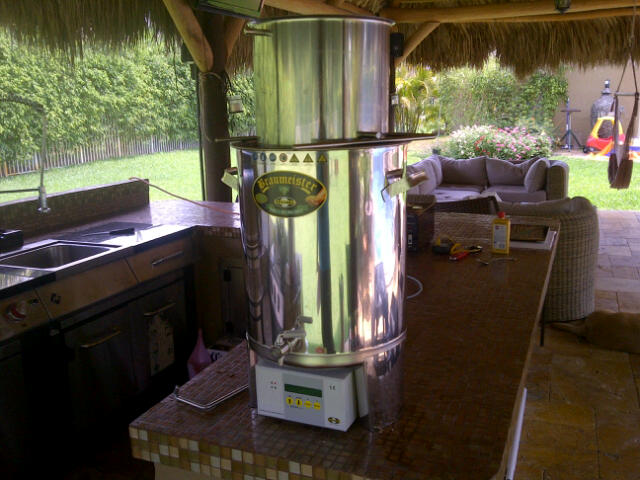So finally realizing starting with 7 gallons and not having a huge boil I wasn't going to get down to my +5.5 gallons of wort. I ended up placing a large sheet of aluminum foil over the top and left and opening about the size of my fist.
This got the boil going good. At this point I put the machine in manual operation and was able to crank up the temperature to 102 degree C. It never got up there but did get to 100C which kept the heating element constantly on.

The unit is pretty easy to clean. I ran PBW with both pumps on and the heating element on for about an hour. Wash with a sponge and drained thoroughly.
This shows the control head. Even though it is in English it gives temperatures in Celsius.

These are the stainless screens and cloths used in the malt pipe. One heavy screen goes in first followed by the stainless cloth. The malt is added then the second stainless cloth and final stainless screen is added. The whole thing is held down by the pipe and wingnut. A gasket on the bottom of malt pipe makes a good seal with the bottom of the pot.

Finally this is the insulating cover on the Braumeister. It is a foam with a vinyl covering. It seems to be well made and I expect it to last quite a while.
All in all the whole routine was stress less, and easy. While the Braumeister is heating and mashing I could be getting things ready for the next step, or cleaning on the fly. You still have hands on. You need to formulate a recipe. Grind grains if you do that, input your mash schedule, temps and times, and add your adjuncts and hop additions. It gives you automation and extreme accuracy. I can now brew on the raining, snowy days that I couldn't before. I can't give thumbs up or down until I sample the brew, for color, haze, smell and flavor. Let you know in about 2 months.

































![Craft A Brew - Safale BE-256 Yeast - Fermentis - Belgian Ale Dry Yeast - For Belgian & Strong Ales - Ingredients for Home Brewing - Beer Making Supplies - [3 Pack]](https://m.media-amazon.com/images/I/51bcKEwQmWL._SL500_.jpg)






























